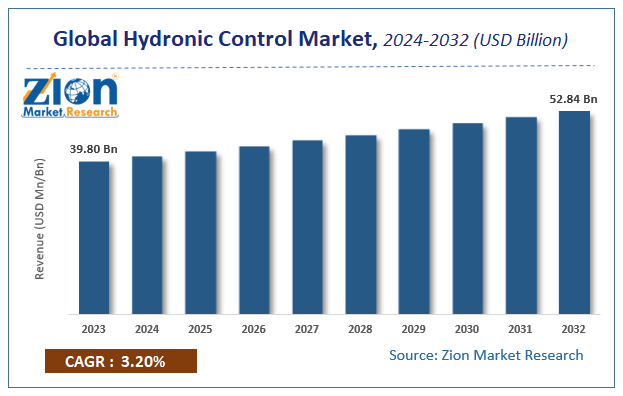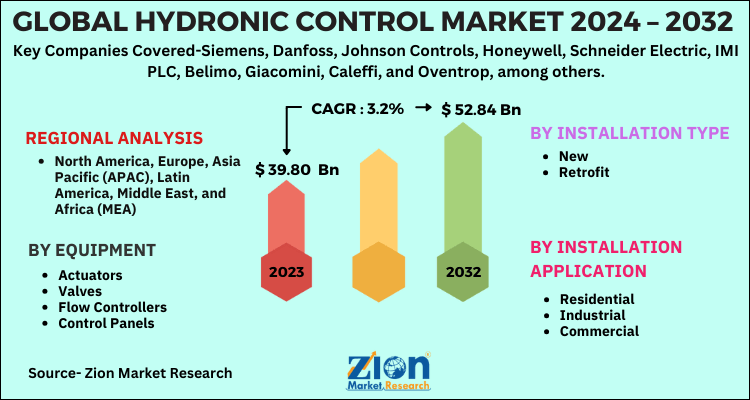Hydronic Control Market Size, Share, Trends, Growth 2032

Hydronic Control Market By Equipment (Actuators, Valves, Flow Controllers, Control Panels, and Others), By Installation Type (New and Retrofit), and By Application (Residential, Industrial, and Commercial), and By Region - Global and Regional Industry Overview, Market Intelligence, Comprehensive Analysis, Historical Data, and Forecasts 2024 - 2032
| Market Size in 2023 | Market Forecast in 2032 | CAGR (in %) | Base Year |
|---|---|---|---|
| USD 39.80 Billion | USD 52.84 Billion | 3.2% | 2023 |
Hydronic Control Industry Prospective:
The global hydronic control market size was evaluated at $39.80 billion in 2023 and is slated to hit $52.84 billion by the end of 2032 with a CAGR of nearly 3.2% between 2024 and 2032.
In order to give the users of this report a comprehensive view of the hydronic control market, we have included a competitive landscape and an analysis of Porter’s Five Forces model for the market. The study encompasses a market attractiveness analysis, wherein all the segments are benchmarked based on their market size, growth rate, and general attractiveness.
Hydronic Control Market: Growth Factors
Hydronics is an intermediate that is used to transfer heat from liquids. The commonly used hyrdonic liquids are glycol, mineral oil, and water. Generally, water radiator is one of the oldest examples of hydronic liquids. Hydronic liquids are basically of two types—hot and cold. Both types require balancing, which requires hydronic control. In the past, in case of large-scale commercial buildings, such as for universities with hostels and big hospitals, the loops of chilled and heated water were provided to maintain hot air or air conditioning. But currently, chiller systems are used to maintain temperature and perfect air passage. The innovation of the chiller system became fruitful as they are efficient enough for residential (homes) and smaller commercial spaces.
The global hydronic control market is likely to experience a significant growth rate in the future, owing to the flourishing construction industry sector in the emerging nations. The ongoing constructional activities owing to urbanization and industrialization are the primary factors boosting this market’s growth. Increase in per capita income of people coupled with high purchasing power is fuelling rapid urbanization. The growing employment opportunities are also contributing to the hydronic control market globally.
Furthermore, the need for energy-efficient buildings among the growing population is likely to positively impact the hydronic control market in the future. Additionally, huge capital investments toward the ongoing constructional activities are further propelling the hydronic control market. However, the high initial investments coupled with the lack of awareness about hydronic controls may hinder the hydronic control market in the years ahead.
The report provides company market share analysis to give a broader overview of the key players in the market. In addition, the report also covers key strategic developments of the market including acquisitions & mergers, new technology launch, agreements, partnerships, collaborations & joint ventures, research & development, technology, and regional expansion of major participants involved in the market on a global and regional basis. Moreover, the study covers price trend analysis and product portfolio of various companies according to regions.
Hydronic Control Market: Segmentation
The study provides a decisive view of the hydronic control market by segmenting it based on equipment, installation type, application, and region.
By equipment, the hydronic control market is segmented into actuators, valves, flow controllers, control panels, and others.
By installation type, the market is categorized into new and retrofit.
By application, the market is bifurcated into industrial, commercial, and residential.
Hydronic Control Market: Report Scope
| Report Attributes | Report Details |
|---|---|
| Report Name | Hydronic Control Market |
| Market Size in 2023 | USD 39.80 Billion |
| Market Forecast in 2032 | USD 52.84 Billion |
| Growth Rate | CAGR of 3.2% |
| Number of Pages | 110 |
| Key Companies Covered | Siemens, Danfoss, Johnson Controls, Honeywell, Schneider Electric, IMI PLC, Belimo, Giacomini, Caleffi, and Oventrop, among others |
| Segments Covered | By equipment, By installation type, By application and By Region |
| Regions Covered | North America, Europe, Asia Pacific (APAC), Latin America, Middle East, and Africa (MEA) |
| Base Year | 2023 |
| Historical Year | 2018 to 2022 |
| Forecast Year | 2024 - 2032 |
| Customization Scope | Avail customized purchase options to meet your exact research needs. Request For Customization |
Hydronic Control Market: Regional Insights
The regional segmentation includes the historical and forecast demand for North America, Europe, Asia Pacific, Latin America, and the Middle East and Africa.
By region, North America contributed an extensive revenue share to the global hydronic control market in 2018 and is expected to dominate globally in the upcoming years as well. This regional growth can be attributed to the stringent environmental rules and regulations regarding sustainability and energy efficiency across the region and the presence of the leading organizations. Europe is expected to provide significant opportunities for the development of the global hydronic control market in the future, owing to the ongoing renovation activities of the old residential and commercial infrastructures and the increasing adoption of IoT in smart housing.
Hydronic Control Market: Competitive Space
The global hydronic control market profiles key players such as
- Siemens
- Danfoss
- Johnson Controls
- Honeywell
- Schneider Electric
- IMI PLC
- Belimo
- Giacomini
- Caleffi
- Oventrop
This report segments the global hydronic control market into:
Global Hydronic Control Market: Equipment Analysis
- Actuators
- Valves
- Flow Controllers
- Control Panels
- Others
Global Hydronic Control Market: Installation Type Analysis
- New
- Retrofit
Global Hydronic Control Market: Installation Application Analysis
- Residential
- Industrial
- Commercial
Global Hydronic Control Market: Regional Analysis
- North America
- The U.S.
- Europe
- UK
- France
- Germany
- Asia Pacific
- China
- Japan
- India
- Latin America
- Brazil
- Middle East and Africa
Table Of Content
Methodology
FrequentlyAsked Questions
The term "hydronic control" denotes the systems and devices that are employed to regulate and govern the flow and temperature of water or other fluids in hydronic heating and cooling systems. The hydronic control components guarantee that the system operates efficiently, maintains specific temperatures, and distributes heat or cooling evenly. These systems employ water as a heat-transfer medium to provide heating or cooling in structures.
The demand for sophisticated hydronic control systems that optimize performance and reduce energy consumption is being driven by the increasing emphasis on energy-efficient heating and cooling solutions. The efficacy and convenience of hydronic systems are improved by the implementation of smart thermostats, IoT-enabled controls, and automated systems that provide remote monitoring and control.
The global hydronic control market size was evaluated at $39.80 billion in 2023 and is slated to hit $52.84 billion by the end of 2032.
The global hydronic control market a CAGR of nearly 3.2% between 2024 and 2032.
The regional segmentation includes the historical and forecast demand for North America, Europe, Asia Pacific, Latin America, and the Middle East and Africa.
Some key players of the global hydronic control market are Siemens, Danfoss, Johnson Controls, Honeywell, Schneider Electric, IMI PLC, Belimo, Giacomini, Caleffi, and Oventrop, among others.
RelatedNews
HappyClients
Zion Market Research
Tel: +1 (302) 444-0166
USA/Canada Toll Free No.+1 (855) 465-4651
3rd Floor,
Mrunal Paradise, Opp Maharaja Hotel,
Pimple Gurav, Pune 411061,
Maharashtra, India
Phone No +91 7768 006 007, +91 7768 006 008
US OFFICE NO +1 (302) 444-0166
US/CAN TOLL FREE +1 (855) 465-4651
Email: sales@zionmarketresearch.com
We have secured system to process your transaction.
Our support available to help you 24 hours a day, five days a week.
Monday - Friday: 9AM - 6PM
Saturday - Sunday: Closed







